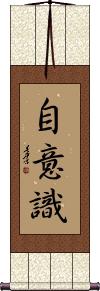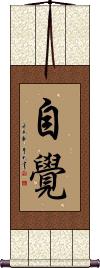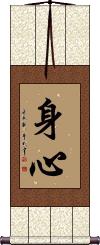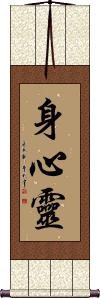Many custom options...
And formats...

Consciousness in Chinese / Japanese...
Buy a Consciousness calligraphy wall scroll here!
Personalize your custom “Consciousness” project by clicking the button next to your favorite “Consciousness” title below...
Self Consciousness
自意識 is the idea of being conscious and self-aware in Japanese Kanji and old Korean Hanja.
This is not a normal word in Chinese.
Consciousness of Self
自覺 is the idea of being conscious, self-aware, and sometimes “on one's own initiative.”
![]() After WWII, they started using a simplified form of the second Kanji for this word in Japan. That version is shown to the right, and you can click on that Kanji if you want the modern Japanese form. Otherwise, the characters shown in the upper left are the correct ones for ancient/old/traditional Chinese, Japanese, and Korean.
After WWII, they started using a simplified form of the second Kanji for this word in Japan. That version is shown to the right, and you can click on that Kanji if you want the modern Japanese form. Otherwise, the characters shown in the upper left are the correct ones for ancient/old/traditional Chinese, Japanese, and Korean.
Body and Mind
身心 means “body and mind” or “mental and physical” in Chinese and Japanese.
In the Buddhist context, body and mind encompass the five elements (skandha) of a sentient being.
The body is the physical material (rūpa) of life. The mind embraces the other four skandhas, which are consciousness, perception, action, and knowledge.
Mind Body Spirit
身心靈 is probably the best way to express the idea of “Body, Mind, and Spirit” in Chinese and old Korean Hanja. We are actually using the word “heart” here because, for thousands of years, the heart was thought to be the place where your thoughts, feelings, and emotions came from. We do something similar in the west when we say “warm-hearted” or “I love you with all of my heart.” In this context, heart = mind in Asian language and culture.
The very literal translation of these three characters is “body, heart & spirit,” which could also be interpreted as “body, mind & soul.”
We have arranged these characters in this order because it simply “feels” like the proper order in the Chinese language. Word lists like this are not so common for calligraphy artwork, so we must be careful to put them in the most natural order. It should be noted that this is not a common title in Asia, nor is it considered an actual phrase (as it lacks a clear subject, verb, and object).
![]() In Japanese Kanji, they use an alternate form of the character for soul or spirit. If you want this using the Japanese alternate, please click on the Kanji shown to the right instead of the button above.
In Japanese Kanji, they use an alternate form of the character for soul or spirit. If you want this using the Japanese alternate, please click on the Kanji shown to the right instead of the button above.
Japanese disclaimer: This is not a natural phrase/list in Japanese. While not totally-natural in Chinese, this word list is best if your audience is Chinese.
Not the results for consciousness that you were looking for?
Below are some entries from our dictionary that may match your consciousness search...
| Characters If shown, 2nd row is Simp. Chinese |
Pronunciation Romanization |
Simple Dictionary Definition |
意 see styles |
yì yi4 i kokoro こころ |
More info & calligraphy: Idea / Thought / Meaning(1) feelings; thoughts; (2) meaning; (personal name) Kokoro Manas, the sixth of the ṣaḍāyatanas or six means of perception, i.e. sight, hearing, smell, taste, touch, and mind. Manas means "mind (in its widest sense as applied to all the mental powers), intellect, intelligence, understanding, perception, sense, conscience, will". M.W. It is "the intellectual function of consciousness", Keith. In Chinese it connotes thought, idea, intention, meaning, will; but in Buddhist terminology its distinctive meaning is mind, or the faculty of thought. |
有緣 有缘 see styles |
yǒu yuán you3 yuan2 yu yüan uen |
More info & calligraphy: Karma ConnectionThose who have the cause, link, or connection, i. e. are influenced by and responsive to the Buddha. |
知識 知识 see styles |
zhī shi zhi1 shi5 chih shih tomoshiki ともしき |
More info & calligraphy: Perception of Knowledgeknowledge; information; (surname) Tomoshiki (1) To know and perceive, perception, knowledge. (2) A friend, an intimate. (3) The false ideas produced in the mind by common, or unenlightened knowledge; one of the 五識 in 起信論. |
見性 见性 see styles |
jiàn xìng jian4 xing4 chien hsing kenshou / kensho けんしょう |
More info & calligraphy: Kensho - Initial EnlightenmentTo behold the Buddha-nature within oneself, a common saying of the Chan (Zen) or Intuitive School. |
身心 see styles |
shēn xīn shen1 xin1 shen hsin shinshin しんじん |
More info & calligraphy: Body and Mind(noun - becomes adjective with の) mind and body Body and mind, the direct fruit of the previous life. The body is rūpa, the first skandha; mind embraces the other four, consciousness, perception, action, and knowledge; v. 五蘊. |
自意識 see styles |
jiishiki / jishiki じいしき |
More info & calligraphy: Self Consciousness |
厥 see styles |
jué jue2 chüeh ketsu |
to faint; to lose consciousness; his; her; its; their Third personal pronoun; demonstrative pronoun; also used instead of 倶. |
昏 see styles |
hūn hun1 hun kon |
muddle-headed; twilight; to faint; to lose consciousness Dusk, dull, confused. |
蘊 蕴 see styles |
yùn yun4 yün osamu おさむ |
to accumulate; to hold in store; to contain; to gather together; to collect; depth; inner strength; profundity (given name) Osamu skandha, v. 塞; older tr. 陰, intp. as that which covers or conceals, implying that physical and mental forms obstruct realization of the truth; while the tr. 蘊, implying an accumulation or heap, is a nearer connotation to skandha, which, originally meaning the shoulder, becomes stem, branch, combination, the objects of sense, the elements of being or mundane consciousness. The term is intp. as the five physical and mental constituents, which combine to form the intelligent 性 or nature; rūpa, the first of the five, is considered as physical, the remaining four as mental; v. 五蘊. The skandhas refer only to the phenomenal, not to the 無爲 non-phenomenal. |
識 识 see styles |
zhì zhi4 chih tsuguhide つぐひで |
to record; to write a footnote (1) acquaintanceship; (2) {Buddh} vijnana; consciousness; (3) (after a signature) written by ...; (personal name) Tsuguhide vijñāna, "the art of distinguishing, or perceiving, or recognizing, discerning, understanding, comprehending, distinction, intelligence, knowledge, science, learning . . . wisdom." M.W. parijñāna, "perception, thorough knowledge," etc. M.W. It is intp. by 心 the mind, mental discernment, perception, in contrast with the object discerned; also by 了別 understanding and discrimination. There are classifications of 一識 that all things are the one mind, or are metaphysical; 二識 q. v. discriminating the ālaya-vijñāna or primal undivided condition from the mano-vijñāna or that of discrimination; 三識 in the Laṅkāvatāra Sutra, fundamental, manifested and discriminate; 五識 q.v. in the 起信論, i.e. 業, 轉, 現, 知, and 相續識; 六識 the perceptions and discernings of the six organs of sense; also of 8, 9, 10, and 11 識. The most important is the eight of the 起信論, i.e. the perceptions of the six organs of sense, eye, ear, nose, tongue, body (or touch), and mind, together with manas, intp. as 意識 the consciousness of the previous moment, on which the other six depend; the eighth is the ālaya-vijñāna, v. 阿賴耶, in which is contained the seed or stock of all phenomena and which 無沒 loses none, or nothing, is indestructible; a substitute for the seventh is ādāna 'receiving' of the 唯識, which is intp. as 無解 undiscriminated, or indefinite perception; there is a difference of view between the 相 and the 性 schools in regard to the seventh and eight 識; and the latter school add a ninth called the amala, or pure vijñāna, i.e. the non-phenomenal 眞如識. The esoterics add that all phenomena are mental and all things are the one mind, hence the one mind is 無量識 unlimited mind or knowledge, every kind of knowledge, or omniscience. vijñāna is one of the twelve nidānas.; Ālaya-vijñāna and mano-vijñāna; i. e. 阿梨耶 | and 分別事 |; v. 識. |
一識 一识 see styles |
yī shì yi1 shi4 i shih isshiki |
One sense or perception; the one individual intelligence or soul which uses the various senses, likened to a monkey which climbs in and out of the various windows of a house— a Satyasiddhi and Sautrāntika doctrine. Also, a Vairocana maṇḍala. |
三識 三识 see styles |
sān shì san1 shi4 san shih sanshiki |
The three states of mind or consciousness: 眞識 the original unsullied consciousness or Mind, the tathāgatagarbha, the eighth or ālaya 阿賴耶識 ; 現識 mind or consciousness diversified in contact with or producing phenomena, good and evil; 分別識 consciousness discriminating and evolving the objects of the five senses. Also 意識 manas, 心識 ālaya, and 無垢識 amala, v. 識. |
九地 see styles |
jiǔ dì jiu3 di4 chiu ti kuji くじ |
very low land; (surname) Kuji The nine lands, i.e. the 欲界 realm of desire or sensuous realm the four 色界 realms of form or material forms; and the four 無色界 formless realms, or realms beyond form; v. 九有, 九有情居, 禪 and 定. The nine realms are:—(1) 欲界五趣地; the desire realm with its five gati, i.e. hells, hungry ghosts, animals, men, and devas. In the four form-realms are:— (2) 離生喜樂地 Paradise after earthly life, this is also the first dhyāna, or subject of meditation, 初禪. (3) 定生喜樂地 Paradise of cessation of rebirth, 二禪. (4) 離喜妙樂地 Land of wondrous joy after the previous joys, 三禪. (5) 捨念淸淨地 The Pure Land of abandonment of thought, or recollection (of past delights), 四禪. The four formless, or infinite realms, catur arūpa dhātu, are:—(6) 空無邊處地 ākāśānantyā-yatanam, the land of infinite space; also the first samādhi, 第一定. (7) 識無邊處地 vijñānānamtyāyatanam, the land of omniscience, or infinite perception, 二定. (8) 無所有處地 ākiñcanyāyatana, the land of nothingness, 三定. (9) 非想非非想處地 naivasaṁjñānā-saṁjñāyatana, the land (of knowledge) without thinking or not thinking, or where there is neither consciousness nor unconsciousness, i.e. above either; this is the 四定. Eitel says that in the last four, "Life lasts 20,000 great kalpas in the 1st, 40,000 in the 2nd, 60,000 in the 3rd, and 80,000 great kalpas in the 4th of these heavens." |
九識 九识 see styles |
jiǔ shì jiu3 shi4 chiu shih kumi くみ |
(female given name) Kumi The kinds of cognition or consciousness (vijñāna); those of sight, hearing, smell, taste, touch, mind, mānas (or阿陁那識 ādāna), i.e. mental perception; 阿賴耶 ālāya, bodhi-consciousness, and 阿摩羅識 amala, purified or Buddha-consciousness. There is considerable difference as to the meaning of the last three. |
亂識 乱识 see styles |
luàn shì luan4 shi4 luan shih ranjiki |
distracted consciousness |
事識 事识 see styles |
shì shì shi4 shi4 shih shih jishiki |
phenomenal consciousness |
二識 二识 see styles |
èr shì er4 shi4 erh shih nishiki にしき |
(personal name) Nishiki two kinds of consciousness |
五智 see styles |
wǔ zhì wu3 zhi4 wu chih gochi ごち |
(place-name, surname) Gochi The five kinds of wisdom of the 眞言宗 Shingon School. Of the six elements 六大 earth, water, fire, air (or wind), ether (or space) 曇空, and consciousness (or mind 識 ), the first five form the phenomenal world, or Garbhadhātu, the womb of all things 胎藏界, the sixth is the conscious, or perceptive, or wisdom world, the Vajradhātu 金剛界, sometimes called the Diamond realm. The two realms are not originally apart, but one, and there is no consciousness without the other five elements. The sixth element, vijñāna, is further subdivided into five called the 五智 Five Wisdoms: (1) 法界體性智 dharmadhātu-prakṛti-jñāna, derived from the amala-vijñāna, or pure 識; it is the wisdom of the embodied nature of the dharmadhātu, defined as the six elements, and is associated with Vairocana 大日, in the centre, who abides in this samādhi; it also corresponds to the ether 空 element. (2) 大圓鏡智 adarśana-jñāna, the great round mirror wisdom, derived from the ālaya-vijñāna, reflecting all things; corresponds to earth, and is associated with Akṣobhya and the east. (3) 平等性智 samatā-jñāna, derived from mano-vijñāna, wisdom in regard to all things equally and universally; corresponds to fire, and is associated with Ratnasaṃbhava and the south. (4) 妙觀察智 pratyavekṣaṇa-jñāna, derived from 意識, wisdom of profound insight, or discrimination, for exposition and doubt-destruction; corresponds to water, and is associated with Amitābha and the west. (5) 成所作智 kṛtyānuṣṭhāna-jñāna, derived from the five senses, the wisdom of perfecting the double work of self-welfare and the welfare of others; corresponds to air 風 and is associated with Amoghasiddhi and the north. These five Dhyāni-Buddhas are the 五智如來. The five kinds of wisdom are the four belonging to every Buddha, of the exoteric cult, to which the esoteric cult adds the first, pure, all-refecting, universal, all-discerning, and all-perfecting. |
五果 see styles |
wǔ guǒ wu3 guo3 wu kuo goka ごか |
(1) five fruits (peach, Japanese plum, apricot, jujube, Japanese chestnut); (2) (Buddhist term) five types of effect in cause-and-effect relationships; (3) (Buddhist term) five effects of ignorance and formations on one's current life The five fruits, or effects; there are various groups, e. g. I. (1) 異熟果 fruit ripening divergently, e. g. pleasure and goodness are in different categories; present organs accord in pain or pleasure with their past good or evil deeds; (2) 等流果 fruit of the same order, e. g. goodness reborn from previous goodness; (3) 土用果 present position and function fruit, the rewards of moral merit in previous lives; (4) 增上果 superior fruit, or position arising from previous earnest endeavor and superior capacity: (5) 離繋果 fruit of freedom from all bonds, nirvana fruit. II. Fruit, or rebirth: (1) 識 conception (viewed psychologically); (2) 名色 formation mental and physical; (3) 六處 the six organs of perception complete; (4) 觸 their birth and contact with the world; (5) 受 consciousness. III. Five orders of fruit, with stones, pips, shells (as nuts), chaff-like (as pine seeds), and with pods. |
五蘊 五蕴 see styles |
wǔ yùn wu3 yun4 wu yün goun / gon ごうん |
the Five Aggregates (from Sanskrit "skandha") (Buddhism) {Buddh} the five skandhas (matter, sensation, perception, mental formations and consciousness); the five aggregates The five skandhas, pañca-skandha: also 五陰; 五衆; 五塞犍陀 The five cumulations, substances, or aggregates, i. e. the components of an intelligent being, specially a human being: (1) 色 rūpa, form, matter, the physical form related to the five organs of sense; (2) 受 vedana, reception, sensation, feeling, the functioning of the mind or senses in connection with affairs and things; (3) 想 saṃjñā, conception, or discerning; the functioning of mind in distinguishing; (4) 行 saṃskāra, the functioning of mind in its processes regarding like and dislike, good and evil, etc.; (5) 識 vijñāna, mental faculty in regard to perception and cognition, discriminative of affairs and things. The first is said to be physical, the other four mental qualities; (2), (3), and (4) are associated with mental functioning, and therefore with 心所; (5) is associated with the faculty or nature of the mind 心王 manas. Eitel gives— form, perception, consciousness, action, knowledge. See also Keith's Buddhist Philosophy, 85-91. |
五陰 五阴 see styles |
wǔ yīn wu3 yin1 wu yin goon ごおん |
(archaism) {Buddh} (See 五蘊) the five skandhas (matter, sensation, perception, mental formations and consciousness); the five aggregates 五衆 see 五蘊. 陰 is the older term. |
人心 see styles |
rén xīn ren2 xin1 jen hsin jinshin じんしん |
popular feeling; the will of the people (1) human nature; human heart; human spirit; kindness; sympathy; (2) (じんしん only) public feeling; people's sentiments; (3) (ひとごころ only) (See 人心地・ひとごこち・1) consciousness; awareness; (given name) Jinshin minds of men |
依識 依识 see styles |
yī shì yi1 shi4 i shih eshiki |
based on consciousness |
僧若 see styles |
sēng ruò seng1 ruo4 seng jo sōnya |
sañjñā; saṃjñā, the third of the five skandhas, i.e. 想 thought, ideation, consciousness. |
內識 内识 see styles |
nèi shì nei4 shi4 nei shih naishiki |
Internal perception, idem 心識. |
八識 八识 see styles |
bā shì ba1 shi4 pa shih hasshiki; hachishiki はっしき; はちしき |
{Buddh} eight consciousnesses (one for each of the five senses, consciousness of the mind, self-consciousness and store consciousness) The eight parijñāna, or kinds of cognition, perception, or consciousness. They are the five senses of cakṣur-vijñāna, śrotra-v., ghrāna-v., jihvā-v., and kāya-v., i.e. seeing, hearing, smelling, tasting, and touch. The sixth is mano-vijñāna, the mental sense, or intellect, v. 末那. It is defined as 意 mentality, apprehension, or by some as will. The seventh is styled kliṣṭa-mano-vijñāna 末那識 discriminated from the last as 思量 pondering, calculating; it is the discriminating and constructive sense, more than the intellectually perceptive; as infected by the ālaya-vijñāna., or receiving "seeds" from it, it is considered as the cause of all egoism and individualizing, i.e. of men and things, therefore of all illusion arising from assuming the seeming as the real. The eighth is the ālaya-vijñāna, 阿頼耶識 which is the storehouse, or basis from which come all "seeds"of consciousness. The seventh is also defined as the ādāna 阿陀那識 or "laying hold of" or "holding on to" consciousness. |
六大 see styles |
liù dà liu4 da4 liu ta rokudai ろくだい |
{Buddh} the six elements (earth, water, fire, wind, void, and consciousness); (place-name) Rokudai The six great or fundamental things, or elements — earth; water; fire; wind (or air); space (or ether); and 識 mind, or perception. These are universal and creative of all things, but the inanimate 非情 are made only of the first five, while the animate 有情 are of all six. The esoteric cult represents the six elements, somewhat differently interpreted in the garbhadhātu and vajradhātu. Also 六大界. |
六通 see styles |
liù tōng liu4 tong1 liu t`ung liu tung rokutsū |
abhijñā, or ṣaḍ abhijñā. The six supernatural or universal powers acquired by a Buddha, also by an arhat through the fourth degree of dhyāna. The 'southern' Buddhists only have the first five, which are also known in China; v. 五神通; the sixth is 漏盡通 (漏盡智證通) āsravakṣaya-jñāna, supernatural consciousness of the waning of vicious propensities. |
六麤 六粗 see styles |
liù cū liu4 cu1 liu ts`u liu tsu rokuso |
The six 'coarser' stages arising from the 三細 or three finer stages which in turn are produced by original 無明, the unenlightened condition of ignorance; v. Awakening of Faith 起信論. They are the states of (1) 智相 knowledge or consciousness of like and dislike arising from mental conditions; (2) 相續相 consciousness of pain and pleasure resulting from the first, causing continuous responsive memory; (3) 執取相 attachment or clinging, arising from the last; (4) 計名字相 assigning names according to the seeming and unreal with fixation of ideas); (5) 起業 the consequent activity with all the variety of deeds; (6) 業繋苦相 the suffering resulting from being tied to deeds and their karma consequences. |
凡識 凡识 see styles |
fán shì fan2 shi4 fan shih bonshiki |
Ordinary knowledge, worldly knowledge, that of the unenlightened by Buddha. |
Click here for more consciousness results from our dictionary
The following table may be helpful for those studying Chinese or Japanese...
| Title | Characters | Romaji (Romanized Japanese) | Various forms of Romanized Chinese | |
| Self Consciousness | 自意識 自意识 | jiishiki / jishiki | ||
| Consciousness of Self | 自覺 自觉 / 自覚 | jikaku | zì jué / zi4 jue2 / zi jue / zijue | tzu chüeh / tzuchüeh |
| Body and Mind | 身心 | shin jin / shinjin | shēn xīn / shen1 xin1 / shen xin / shenxin | shen hsin / shenhsin |
| Mind Body Spirit | 身心靈 / 身心霊 身心灵 | mi shin rei mishinrei | shēn xīn líng shen1 xin1 ling2 shen xin ling shenxinling | shen hsin ling shenhsinling |
| In some entries above you will see that characters have different versions above and below a line. In these cases, the characters above the line are Traditional Chinese, while the ones below are Simplified Chinese. | ||||
Successful Chinese Character and Japanese Kanji calligraphy searches within the last few hours...







